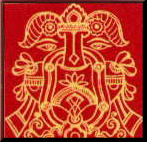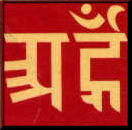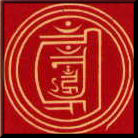|

Samyakta
(righteousness) is the very essence of self-mediation. Sramana Bhagvan Mahavir has said
that he who has no Samyaktva cannot cultivate right conduct.
‘Samyaktva’ is
the first letter of the alphabet of self-mediation. Without samyaktva, there can be no
destruction of karma. If there is no samyaktva in life, all sorts of worship and
meditation are considered useless, like zero without the figure 1. The simple meaning of
samyaktva is ‘faith’.
To have faith in the
eternal truths is called ‘Samyaktva’.
There are six eternal
truths.
1. The soul exists,
2. The soul is eternal (immortal),
3. Only the soul is the agent of karma,
4. Only the soul is the endurer and enjoyer of fruits,
5. The soul is bound by karma,
6. The soul gets liberated after getting rid of karma..
This means that there is
liberation. It is absoultely necessary to have faith in these six eternal truths. Also to
have faith in the nine tattvas (categories) - Jiva, Ajiva, Papa, Punya, Asrava, Samvara,
Nirjara, Bhandha and Moksa is ‘Samyaktva’.
Samyaktva is also called
‘Samakita’. To see, know, think and speak of a substance as it is i.e. in its
real from, is samakita or samyaktva.
Every
living being has perception, knowledge and conduct, but meditation does
not result by the mere presence of these three. To entertain and acquire samyaktva is absoultely necessary for the glorious
sucess of meditation.
Therefore Sramana Bhagvan
Mahavir said, ‘Right perception, right knowledge and right conduct lead a person to
liberation. And these three are successive. There is no right knowledge without right
perception; one cannot have right conduct without right knowledge. There can be no
destruction of Karma without right conduct. there is no liberation without the destruction
of karma.
Thus, ‘Samyaktva’
is the foundation-stone of self-meditation. There are many divisions and sub-divisions of
‘Samayaktva’.
Characteristics
Five characteristics have
been laid dawn to show whether samyaktva or samkita has been incorporated-embedded in
one’s life. He who shows these five traits as a part of his life is called Samakitin.
The following are its
characteristics :
1. Sama
(Equanimity) - He who shows
equanimity in all dualities i.e. pairs of opposites such as attachment and hated;
happiness and unhappiness; conjunction and disjunction; friend and feo; who does not
become unhappy in miseries and who does not become proud in happiness.
2. Samvega -
(Non-attachment) - One is not
attached to all worldly objects as they are transient; he becomes indifferent to all
wordly relations and takes interest in detachment every moment.
3. Nirveda
(Detachment) -
One is not
attached to possession, does not commit sinful activities, keeps away as far as possible,
from sinful activities and possession, is self-controlled and considers wordly life as
insignificant.
4. Anukampa
(Compassion) - One shows the
feeling of compassion to every living being and continues to show it; does not hurt
intentionally any living being and tries to soothe the sorrow of unhappy persons according
to his capacity.
5. Astikya
(Religiosity) - One should
show full faith in religious tenets propounded by the Sarvajna Bhagvan, should behave
accordingly and should always lead a religious life and preserve faith. This is called
‘Astikya’.
Over and above these, some
other characteristics of samakita are also described.
 Mithyatva
(Perversity) Mithyatva
(Perversity)
The chief and important cause
of karma-bondage is Mithyatva (perversity).
Mithyatva means - to
understand, believe think and practise in an a contrary manner in every matter. For
example, those who are mithyatvi (perverse), consider religion as non-religion and
non-religion as religion; an ascetic as a non-ascetic and a non-actetic as an asectic,
etc.
There are 25 types of
mithyatva.
Literature
" For further study please read ‘Tattvarathasutra’, ‘Samyaktva,
Saptatika’, the Sajjhava of 47 ‘bol’ of samyaktva, etc."
 Syadvada
(Theory of relativism) Syadvada
(Theory of relativism)
The method of
discussion adopted by Sramna Bhagvan Mahavira to bring about harmony in controversial
discussions is known as Syadvada or Anekantavada. This method of discussion is a precious
and original contrubution of Jainism to the word.
Syat - vada - Syadvada-syat
means ‘from a particular angle’ or ‘from a particular viewpoint’,
‘may be’. To discuss to understand, from many angles and viewpoints is
‘Syadvada’.
The compound
‘Anekanta’ is composed of 2 words - ‘Aneka’ and ‘anta’. The
word ‘Anta’. does not mean ‘the ultimate’. or ‘the end’ or
‘the full point’ or ‘finished’. Here the word ‘Anta’ means
‘viewpoint’, ‘angle’, direction’ ‘side’ or
‘quality’.
To discuss, to undertand
from many viewpoints, many angles, many directions and many sides is Anekatanvada.
These two words
‘syadvada’ and ‘Anekantavada’ are synonymous. This they suggests to
man that he should see, grasp and understand that ‘truth there is, at the other end
also’. It teaches man to see and think over a matter from a broad angle, This method
of thinking and acceptance says - What I say is not the whole truth but there is truth in
what the other man states and it clutivates liberaly and tolerance.
Syadvada has been explained
in seven ways. It is called ‘Saptabhagi’ or saptabhangi Naya.
The seven Nayas are :
1. Is (Asti) 2. Is not
(Nasti) 3. It is, is not (Asti-Nasti) 4.Is Indescribable (Avaktavya) 5. Is Indescribable
(Asti, avaktavya) 6. Is not, Indescribable (Nasti, avaktavya) 7. Is, is not , Idescribable
(Asti, Nasti, avaktavya).
Examples :
A person is on death-bed. A doctor treats him. The relatives of the sick person ask the
doctor seven questions. The doctor replies in seven ways.
1. His
health is good (Asti)
2. His
health is not good (Nasti)
3. It is
better than yesterday but is not better than what one can hope for. (Asti-Nasti)
4. It is
impossible to say whether his health is good or bad. (Avaktavya)
5. It is
better than what it was yesterday (asti) but one cannot say (avaktavya) what will happen
(Asti, avaktavya).
6. It is
not better than what it was yesterday (Nasti) but one cannot say, what will happen
(Avaktavya) (Nasti, avaktavya)
7. It is
not good (Nasti) but it is better than it was yeasteday (Asti) but one cannot say
anything. (Avaktavya, Asti, Nasti).
For understanding this
Saptabhangi, the example of seven blind men and an elephant is wel-known.
Thus the right knowledge of
a thing can be acquired by this ‘Syadvada’ - a unique doctrine.
Literature
For further study, please
read ‘Syadadaratakara’, Syadvadamanjari’, ‘Sanmatitarka’, etc.
 Nayavada
(The theory of Nayas) Nayavada
(The theory of Nayas)
The method
of discussion accepted by Sramana Bhagvan Mahavira, not to inflate controversy but to
bring about harmony in it, is known as Syadvada, Anekantavada or Nayavada. This method of
discussion is idded an original contribution of Jainism to philosophy.
A thing, an individual or a
thought has infinite attributes. To discuss a thing by emphasising on particular attribute
out of many and by becoming idifferent to its other attributes, is called
‘Naya’.
To see, think about a part
of ‘Parmana’ (Instrument of valid cognition) is ‘Naya’.
Th think about or discuss
anything from a particular angle, that is, relatively, is ‘Naya’.
There are seven types of
‘Naya’.
1. Naigama Naya - Popular standpoint. 1. To consider a
thing, as a whole contains attributes in part only. 2. To consider a thing not as a whole
though it may have attributes in whole as suggested by its name - this is called
‘Naigama Naya’. In this Naya any one out of the attributes and the substance are
considered as secondary and the other one as primary or principal.
For example, while taking
tea, it was spilled on some cloth. A man shouts out immediately - ‘My shirt is
spoiled.’ While writing, the nib is broken. A man says, ‘My pen is broken’.
Here, in reality, the whole
shirt is not spioled. The whole pen is also not broken, yet, ti is said so, considering
the part as the whole.
2. Sangraha Naya
(Synthetic Standpoint) -
To
put it in simple terms, understanding much from less is sangraha naya. A man following
this naya believes in the general and does not speak of the particular.
For example, somebody says,
‘There is a garden.’ One who hears this, immediately understands that there are
things like trees, flowers, etc. in the garden.
3. Vyavahara Naya
(Empirical standpoint) - To
think of a thing in detail is ‘Vyavahara Naya’.
For example, one following
‘sangraha naya’ would say that ‘there is a cloth-shop there’. The
other person following the vyavahara naya would say that there is a cloth-shop selling
cloth of a particular mill.
4. Rijusutra Naya
(Straight-thread stand point) -
To think of the present only is Rjusutra Naya. Riju means ‘Simple’,
‘Straightworward’, sutra means ‘to think’. To think in a simple way,
to accept what is happening before our eyes, is Rijusutra naya.
For example, a person
following this naya would not call a person who does not follow the duties of an ascetic,
an ascetic, though he may have put on the clothes of an ascetic.
If a man thinks evil of
somebody, while counting the beads of a rosary, he would be called a bad man, a
pretentious man according to this naya.
5. Sabdanaya
(Verbal Standpoint) - To
consider words denoting tense or gender as one, though there may be a difference in the
words. One, following this naya, does not consider whether there is an attribute or not in
a thing according to the meaning of each word denoting different names. He only considers
the original name.
For example, Purandara,
Sacipati, Devendra, etc. are different names of Indra, but a person following this naya
considers each word as denothing Indra, that is, he comprehends the meaning
‘Indra’ only, though they may have different etymological meanings.
Moha, Asakti, Raga,
Mamatva, Vasana, Prema - all these are synonymous terms. But a person following this naya
would take ‘love’ as their meaning, though they may have different shades of
meaning.
6. Samabhirudha
Naya (Conventional standpoint) -
To think of the meaning of a word according to its etymology is ‘Samabhirudha
Naya’.
A person following this
naya considers only the etymological meaning of a word.
For example, when sexual
instinct and activity are seen in the relation between a man and a woman, a person
following this naya would not call it the relaion of love, but the relation of passion.
7. Evambhuta Naya
(Actualistic standpoint) - The
word which connotes its present meaning and is equal to the purpose shown by the meaning
is called ‘Evambhuta Naya’.
To think competely of the
three, the name, the work and the result, is ‘Evambhuta Naya’.
A person following this
naya considers only him a policeman who actually performs the duty of a policeman. He is
called a worshipper, who is actually performing worship.
There are totally 700
divisions of these seven nayas.
The chief, the Nigama naya
has 10; the Sangraha, 6 or 12; Vyavahara; 8 or 14; Rijusutra, 4 or 6; Sabha, 7;
Samabhirudha; 2; and Evambhuta 1 divisions.
Explaining Dharma
(Religion) from the viewpoint of Naya :
1. The follower of
Nigamanaya says - All religions are religions i.e. equal.
2. The follower of Sangrahanaya says - That is religion which has been started by my
elders.
3. The follower of Vyavahara Naya says - Religion is the cause of happiness. To perform
meritorious deeds is religion.
4. The follower of Rijusutra says the result of detachment with conscious activity is
religion.
5. The follower of Sabdanaya says : Samakita is the origin of religion and samkita itself
as religion.
6. The follower of samabhirudhanaya says : To know the nine tattvas, to give up those
tattvas that deserve to be given up and to put into practice those that are worth
practising, is religion.
7. The follower of Evambhutanaya says : That is religion, which destroys karmas and makes
one liberated.
Thus, thinking of the nine
tattvas and other matter with the help of the seven nayas, relative part-truth is
accepted. Thus, controversy can be avoided and harmony can be established.
Literature
"For, further study
please read ‘Naya Rahasya’, ‘Anuyogadvara sutra’ and other
books."
 Pramana
(Instrument of Valid Cognition) Pramana
(Instrument of Valid Cognition)
That is called
‘Pramana (instrument of Valid Congnition), by which a thing can be properly cognised
and understood. Though right knowledge, doubt, illusion, etc. are removed and truth is
understood, grasped. True knowledge is considered ‘Pramana’. Through Pramana, a
thing worth knowing can be known (jneya); a thing worth accepting, can be put into
practice (upadeya).
Pramana is also knowledge.
There are 4 types of Pramana.
1. Pratyaksa
Pramana (Direct knowledge through the senses) - To know a thing directly through the senses is ‘Pratyaksa
Pramana’. It has more than one division and sub-division.
2. Anumana Pramana
(Inference) -
To know a thing
through inference, or logic is, ‘Anumana Pramana’. For example, on seeing smoke,
one infers that something is burning there, it has more than one division and
sub-division.
3. Agama Pramana
(Revelation) - To know a thing
through scriptures written by spiritual authorities. It has 3 types.
4. Upama Pramana
(Comparision) - To know a
thing through comparison is ‘Upama Pramana’. For example, the Tirthankara
Padmanabha in the forthcoming group of 24 Tirthankaras will be like Sri Mahavira Svami,
the Tirthankara of the present group of 24 Tirthankaras.
Literature
For further study, please
read ‘Pramananayatattvalokakara’.
 Niksepa Niksepa
Language is a vehicle of
knowledge. Intangible knowledge becomes tangible through the medium of language and
becomes practical.
Language consists of words.
Generally words are used in 4 ways. This use is called Niksepa.
To see merit or demerit in
a thing bearing a name and then to reveal its pure or impure form is called, Niksepa.
There are 4 types of Niksepa.
1. Namaniksepa - This is called ‘Namaniksepa’
by which a thing is known.
For example, a table is
known, when we speak the word ‘table’.
There are 3 types of this
Niksepa.
2. Sthapananiksepa - That which is known by the image of an
original thing, is called ‘Sthapananiksepa’.
For example, god is known
by seeing an image or a picture of god. This Niksepa has 40 types.
3. Dravyaniksepa -
A substance is there but it has no
qualities according to its name or its qualities are not revealed uptil now.
This is called ‘Dravya
Niksepa’.
For example, one studies
the Scriptures or the sutras but does not understand their meaning, or, one studies with a
vacant mind.
This nikespa has more than
one division and sub-division.
4. Bhavaniksepa -
If a thing is known by its own
qualities, it is called ‘Bhavaniksepa’.
For example, to study
Scriptures or sutras with a concentrated mind and to understand their meaning and purport.
Literature
For further study, please
read ‘Anuyogadvarasutra’.
 The Five
Samavayas The Five
Samavayas
A living
being experiences happiness or misery; there is good luck or bad luck in his life. Only
one cause, power or god is not responsible for it; but diversity in life is seen and
experienced by the gradation fo the five causes. To bring about harmony in controversy
over the causes of happiness and misery, Sramana Bhagvan Mahavira has promulgated a new
method of thinking. It is known as Panca Samavayas (The group of five causes).
‘Samvaya’ means
‘a group’ and Panca means ‘five’. This group of the five causes make a
joint contribution in the diversity of life.
It is as follows :
1. Kala - Kala (time) has sovereignty over all the
elements of the world. Kala is the performer and the taker. Kala means ‘Time’.
The result ensures only when the time ripens. Nothing happens at the improper or
inopportune time.
For example, when you sow
some seed, it does not yield fruit immediately. A tree gets fruits with seeds after some
fruits ripen.
The child is not born
immediately as soon as conception takes place. The child is born after some definite fixed
time.
The sun, the moon, the tide
and the ebb, etc. follow the dictates of time.
But to believe merely by
this, that time only is the director and controller of the world is wrong. It is necessary
to think of other causes also for things to happen.
2. Svabhava
(Nature) - Svabhava is the
main cause in all that happens. A woman does not grow a beard or mustaches even though the
time has ripened. A barren woman does not give birth to a child. Certain trees do not
yield fruits, even when the time has ripened. Time is, therefore, not the only cause;
nature also plays its part.
It is the nature of a bird
to fly in the sky. The nature of fish is to swim in water. The cuckoo possesses sweet
voice by nature. Thus, every one has its own nature. We see diversity in life on account
of different natures.
3. Niyati (Destiny) - Every thing is predetermined. Whatever
is to happen, happens. Nobody can make any change in it. To believe thus is fatalism,
destiny.
The fatalist does not
believe in time and nature as causes. He considers every incident as pre-determined. He
has a definite belief that whatever is pre-determind cannot be changed, even after making
efforts.
4. Karma - As you sow, so you reap. Good deeds
yield good fruits; and bad deeds, bad fruits. The Karmavadi who believes in this way,
refuses to accept time, nature and destiny to be the causes and considers
‘Karma’ as the chief and important cause.
5. Purusartha
(Human effort) - Human effort
does every thing. Misery can be changed into happiness through effort. The believer in
human effort does not accept time, nature, destiny and karma as causes. He gives
prominence to human effort only.
It is wrong to consider any
one out of these five as the dominant and the others as secondary. All these five in
gradation contribute to the result.
For example, One soul is
liberated. The aforesaid five causes contribute to its liberation.
1. As the time ripens, he
acquires samyaktva (righteousenss)
2. It is the very nature of the soul that seeks liberation, to make an effort for
liberation.
3. He makes an effort, he performs some religious mediation.
4. The karmas are destroyed, annihilated.
5. It is destained that he will be liberated, and he is liberated.
Thus, this group of five
causes remains joint.
Literature
For further study please
read ‘Anuyogadvara Sutra’.
|

